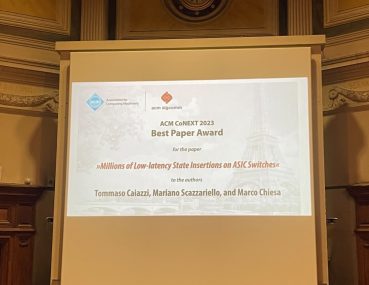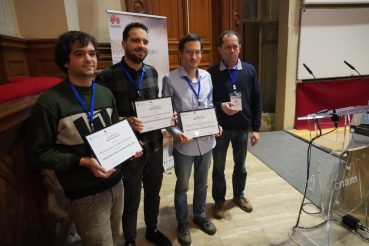Dejan is deeply honored to become a Wallenberg Scholar! This grant comes with 18 MSEK in funding over five years. More information is available at the KAW website.
We are hugely honored that our “Millions of Low-Latency Insertions on ASIC switches” paper received the Best Paper Award at ACM CoNEXT 2023! More details are available in our earlier post.


From left to right: Tommaso Caiazzi, Mariano Scazzariello, Marco Chiesa, Olivier Bonaventure (TPC co-chair)
We were once again at the ceremony at which KTH is officially awarding doctoral degrees. This time it was Alireza Farshin’s time, and we used the beautiful Stockholm City Hall to recreate our favorite hallway shot!

Our “SEMLA: Securing Enterprises via Machine-Learning-based Automation” project proposal has been selected for funding by Vinnova. The project cost is 12MSEK with Prof. Marco Chiesa as the PI. Other project partners include members from the Computer Security group from KTH, the Connected Intelligence unit at RISE, RedHat, and Saab.
The SEMLA project seeks to make the development of software systems more resilient, secure, and cost-effective. SEMLA leverages recent advancements in machine learning (ML) and artificial intelligence (AI) to automate critical yet common & time-consuming tasks in software development that often lead to catastrophic security vulnerabilities.
Today’s network functions require keeping state at the granularity of each individual flow. Storing such state on network devices is highly challenging due to the complexity of the involved data structures. As such, the state is often stored on inefficient CPU-based servers as opposed to high-speed ASIC network switches. In our newly accepted CoNEXT paper, we demonstrate the possibility to perform tens of millions of low-latency flow state insertions on ASIC switches, showing our implementation achieves 75x memory requirements compared to existing probabilistic data structures in a common datacenter scenario. A PDF of the paper will soon be available. This was joint work between Mariano Scazzariello, Tommaso Caiazzi (from Roma Tre University), and Marco Chiesa.
